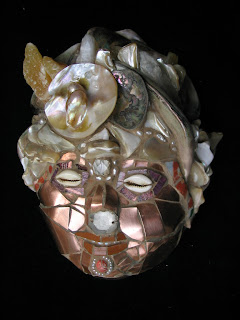

I remember reading a popular text on mosaic art with a statement in it that puzzles me to this day. It read, "Mosaic is a European art form. Many cultures have made mosaics but it is a European art form." Although it is true that mosaic art, as many artists and historians understand it, is heavily slanted towards Europe, the pronouncement in this book is something of an oxymoron. Further, since much of my own inspiration in mosaic art comes from non-western sources, I am particularly cognizant of not being entirely mainstream in my interests and influences. Yet these influences are rich with meaning, history and materials and for this reason I seek to share with audiences whenever possible these sources of splendor and wonder which are often neglected in contemporary discussions of mosaics.
To this end I had organized a panel on non-western mosaics for the Society of American Mosaic Artists (SAMA) conference in Mesa Arizona last year. This month I have published a review on Turquoise Mosaics From Mexico in the British Association for Modern Mosaics (BAMM) newsletter. It apparently isn't online yet but one can go to the BAMM website and become a member. In the mean time here is an excerpt of my review:
Turquoise Mosaics From Mexico, by Colin McEvan, Andrew Middleton, Caroline Carwright and Rebecca Stacey is a long overdue study of Pre-Columbian mosaic artifacts. Published by the British Museum and Duke University press in 2006, the book sheds new light on a subject first researched by Elizabeth Carmichael. Ms. Carmichael’s Turquoise Mosaics From Mexico, published in 1970, has long been out of print and this new study successfully brings the subject up to date. New excavations and updated scientific analysis provides a plethora of information on these exquisite objects.
What makes Turquoise Mosaics From Mexico of special interest to mosaic artists is the information on how and why particular materials were used, their origins and ritual significance. Also very useful for visual artists are the illustrations of multiple views of objects and magnified images of their details. The illustrations allow the reader vantage points typically not seen from texts or even first hand as a museum goer. At times we can peer into the open mouth of a decorated beast and see its bejeweled interior. Or we can see its underbelly or view the obverse side. It is the next best thing to being able to hold these artifacts in hand and turn them about to investigate the ingenuity of the Mixtec-Aztec craftsmen.
I truly enjoyed reading this book and perusing the great illustrations. These objects inspired a series of mosaic masks that I am still working on. My latest masks, pictured above, are about the size of a baby's head and embellished with glass, copper, ceramic, gold and semi-precious gems on a ceramic base. I've presented these to the South Carolina State Arts Commission for consideration for their Verner Awards Luncheon. If accepted, they will be on display at that function. If not, they will rest in my utility room until I take them up to an art festival in Westminster, Maryland this summer.
1 comment:
Hi Janet
Enjoyed reading your post. Love looking at your mask. Hope to see you in Miami at the Conference. Laura Aiken
Post a Comment